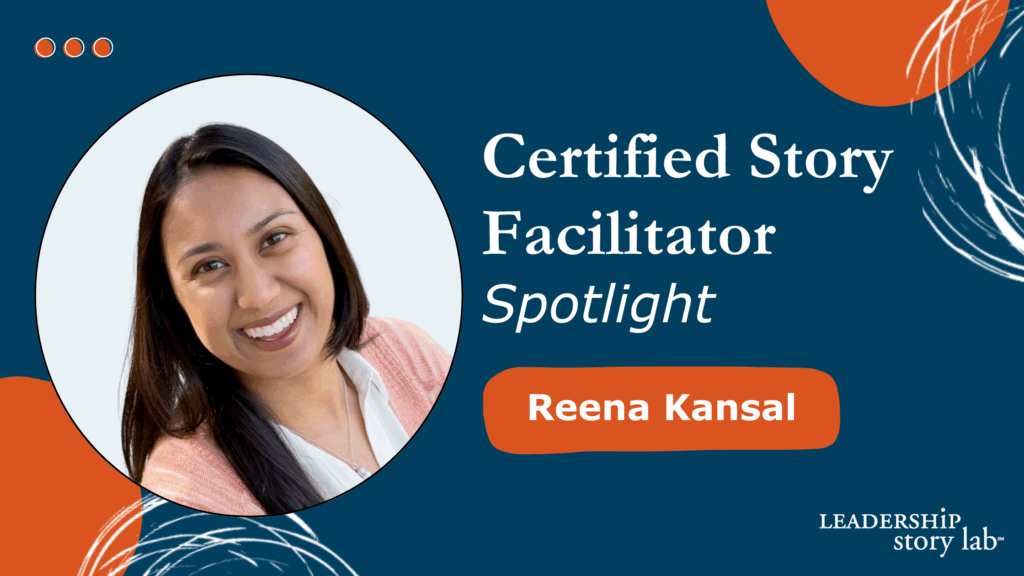October 21, 2025 / Leadership Story Lab

Reena Kansal’s family and friends were surprised when she joined a storytelling company. She had been an engineer-cum-consultant and product manager living and breathing technical details. Now Leadership Story Lab’s Chief Operating Officer, Reena loves how creativity is unlocked through the structure she’s learned in Leadership Story Lab’s Certified Story Facilitator training program. As the COO, she works on business development, marketing, client services and operations. She sees herself as the glue holding many different parts of the company together — using what she sees, hears, and experiences to support her team and her clients. She was in the first cohort of Leadership Story Lab’s Certified Story Facilitator (CSF) training and it has impacted her everyday interactions and relationships — the core of who she is both at work and at home.
Leadership Story Lab: You were in the first CSF cohort back in 2020. So five years later, what has been the most impactful part of the training?
Reena: Oh, so many. What really sets CSF apart is that our work really starts with listening. Aggressive listening is one of the skills that we really hone in, master, and practice during all three levels of CSF. This is what sets Leadership Story Lab apart. Our work starts with listening. CSF has helped me hone these skills to better serve our clients.
Reena uses her aggressive listening skills in her role as COO to understand clients’ needs and how Leadership Story Lab can serve them.
In our discovery process, I try to understand where they’re coming from before proposing a solution. Recently, I had two clients say they chose Leadership Story Lab because we were willing to understand their company and their culture first and not just come in and say, “Hey, this is how we do it. We’ve done this a hundred times and we know this works.”
Listening is also related to asking Crazy Good Questions to help learn about their leaders, team, culture, goals, and the challenges that they’re facing. I’ve learned to weave in story-prompting questions into every conversation I have. These questions provide purpose and help me make meaning out of what I’m hearing. For example, I start business development calls with “What inspired you to learn more about storytelling? Or at networking events, I like to ask, “What has been the highlight of your week?”
I use Crazy Good questions every day, even with my family. My kids joke and tell me, “Mom, you’ve reached your question quota for the day,” when they come home from school.
IRS is another important takeaway that I use every day. It’s taught at all levels of CSF and I’ve been trying to apply it in different formats including in emails, the way we design training, coaching, prep work, and proposal decks for clients.
It is Esther’s genius that IRS not only applies to an individual story, but you can use it for presentations and workshops. The general structure is IRS, and each section has a mini IRS in it.
At a recent Penn State Future of Work conference, a conference attendee had an ah-ha moment when she realized that she could develop her class using this method, thinking of her semesters using the structure of IRS, too.
Having the IRS structure helps turn an idea into a great story. The questions release creativity because they make you think about things from a different perspective. IRS provides a structure to make the story more compelling. The strategic sequencing and frameworks of how to build the I, R, and S is what can help — even an engineer like me — tell engaging stories. IRS structure makes it easy to follow and apply.
CSF has also helped me connect the dots better. In Level 3 we work on story synthesis. Whether I’m facilitating and connecting different comments together or I’m hearing different goals from clients, I’m able to connect the dots quickly and easily. I synthesize the story a lot faster and quicker now that I am a certified Level 3 story facilitator.
CSF offers a progressive certification model, with each level offering signature storytelling tools and areas of mastery. For Level 3, the focus is on the Mastering of Story Synthesis. Here, participants learn to fuse disparate narratives into one coherent whole.
One example that comes to mind is a recent experience with my niece. She is a master’s student, starting to go on job interviews. At dinner, she was basically recounting events of her day — how she didn’t know she had a quiz in class. And then she got there and her friends told her there was a quiz. She had 15 minutes before class, so she started cramming for her quiz. She then went on to talk about job interviews and how she has the tendency to ramble. My niece was looking for help in preparing for job interviews, and she didn’t know what to say. That is when I shared this example with her.
I was then able to model how to share a leadership story. I told her, “You can use the example about studying for your quiz in a way that showcases your character. You didn’t have time to prepare, but as soon as you realized the challenge, you took the resources you had to pull yourself together, get organized and do what you needed to do to be ready. That’s a quality and a characteristic of who you are that could be helpful in the workplace.”
It may not be the perfect story, but taking what I heard and where she was going, I was able to weave together a compelling narrative.
“Recounting events is NOT telling stories.” Esther Choy, “It’s the strategic sequencing of fact and emotion.”
This helps when I facilitate Story Lab. People come in with different stories, different scenarios, and based on what they’re sharing I can help them connect the dots. As you go through the three CSF levels, the frameworks become ingrained in you. You can suggest things on the fly like this.
Leadership Story Lab: Let’s talk more about Level 2 and 3.
Reena: In Level 2, we learn the exercise called Passion DNA. I’ve used this to help people who are reluctant to see themselves as leaders. One example that comes to mind is my cousin who was writing his college application essay.
Passion DNA helps people unlock their authentic voice by mining their passions — hobbies and pursuits outside of work — to describe their values using original and metaphoric words tied to their passion. Then, they weave them into a leadership narrative.
He felt like he hadn’t done anything interesting and didn’t know what to write about. And by using Passion DNA, I was able to unpack his hobby, what skills and traits made him successful in his hobby, and then translate that into what he can write about and how it applies to what he wants to do in the future.
I used these same tenets when I was coaching the CFO of a software company. She was struggling with imposter syndrome because she didn’t go to an Ivy League school and was often the only woman in the room. But through uncovering her stories, she became more confident that she is very qualified to be in the role.
Leadership Story Lab: That is so powerful. Can you speak about what you learn in Level 3?
In Level 3, we focus on understanding different points of view, which is the key to understanding your audience. Whether it is with a potential client or anytime you’re telling a story, as Esther says, “The story about you is not really about you.” It’s about connecting to your audience.
That goes hand in hand with analyzing your audience and trying to think about what would be intriguing for your audience. For example, to prepare for a keynote for the Illinois CPA Society Corporate Finance Conference I needed to understand my audience, so I spoke with the organizer to get insight on who attends, their backgrounds, and the topics they are interested in.
The other thing I did was my own research. To learn about what’s top of mind for this group of people. I also reached out to a few folks in the industry to get a sense of what they’re working on and what’s been challenging them lately. I learned a lot of new things that I wasn’t expecting to learn from this research. For example, accountants want to attract new people into the field and they are always fighting the “party pooper” stereotype — that accountants always say no to new initiatives. But in reality accountants are a strong asset to strategic decision making.
This helped me shape my talk and understand what would be important for this audience, and when I was coaching the CEO of a consulting company who was preparing to speak at a conference. She was having trouble knowing where to start and what to talk about. But I used parts of story discovery from Level 2 and understanding his audience from Level 3. I helped her brainstorm some story ideas, and then asked, “What theme do you want it to have? What do you want to leave with your audience?”
Then, I helped her use IRS to shape that speech to have a nice flow and have a clear takeaway at the end.
In Level 3, we also spent time on visuals — creating a visual that explains a complex concept to your audience, and then unveiling that visual as you share that story. I’ve tried to share visuals and I notice visuals more now. I went to buy a car and they tried to sell the whole car insurance package up front. The salesmen drew us a visual to explain the different options and the complexity between what our options were. The simple visual did make it easier to understand. Of course, my curiosity and role as story collector kicked in and I asked him how he came up with this visual and process behind it.
“To become a great storyteller, one must first become a great story collector” — Esther Choy
With CSF, you just start noticing different things everywhere and asking different things. When you’re buying a car, you’re waiting around a lot. So I asked a crazy good question, “How did you get into car sales?” to our sales person, and it opened the door. I learned her whole life story. When I came home, I told my kids and they asked, “How’d you learn her whole life story in the 10 minutes you were hanging out with her?”
Good questions and listening. This isn’t a one time thing. When I was in CSF I went to the Salvation Army to donate. Usually I just drop it off and leave. But that day, I paused, and I asked the person, What inspired you to volunteer here? I learned that he had been homeless, and the donations from the Salvation Army got him out of his situation. He now has a home, a steady job. So he likes to give back and volunteer because the Salvation Army helped him get through that. One small question turned a transaction into something transformational. I see volunteers differently. I feel the direct impact of my donated items.
Leadership Story Lab: Yes, that’s transformational. You get the chance to facilitate storytelling as part of your job. Have you seen this kind of transformation with your clients too?
Reena: I have been able to help my coaching clients uncover some pretty powerful stories that they normally wouldn’t share. But through our coaching, they decided to share and received incredible feedback.
I just got an email from a client who I helped prepare for speaking at a conference. She thanked me for encouraging her to share her story. Afterwards, she was in the women’s bathroom, and a woman pulled her aside and told her, “I and everyone in that room will never forget the story you shared.” This client appreciated the support on her storytelling journey — because it really is a journey.
That’s the most rewarding part of my job. Helping others connect to their audiences and giving others the confidence and the courage to tell their stories.
Leadership Story Lab: That’s a theme that Rissa Redden also brought up in her CSF interview — having the confidence and courage to tell stories. She spoke about how, if you try storytelling one time, you’re likely to try it again. In your experience, what are some of the tools that help people gain the confidence and courage to tell stories?
Reena: For most people, storytelling is out of the norm. You need someone cheering you on, saying it’s okay to try it. That’s part of our job as a facilitator — to cheer them on. Once you try storytelling a few times, you actually see that it becomes more natural to you. You want to do more storytelling because of the reaction you get.
I think some people are afraid of standing out, but storytelling makes you stand out in a good way. It doesn’t have to be as scary as standing on a stage. A lot of times, storytelling happens in one-on-one communication. If you’re doing something that leads to good conversation, you want to do it more and more.
Now even if I go to a party, I ask myself, what am I going to talk about at this party when I meet these people I haven’t seen in years? I come up with one or two questions just get the conversation going, and that really helps ease the conversation. That way you can avoid the usual banter of, “Oh, how’s the weather? How’s everything going? Oh, everything’s great.” It helps you make actual connections.
Leadership Story Lab: You help lead the CSF monthly professional development calls. What are those like?
Reena: They’re great. They give me the inspiration I need to keep going every month. It’s a supportive, thoughtful community. I always learn something new in each of our meetings and from each of the facilitators. I’m lucky because I get to interact with them one-on-one, outside of the monthly meetings. Hearing what all the CSFs are up to and what they’re doing and the impact they’re having is always inspiring.
We also cover a wide range of topics. Everything from acting tools and body language to poetry and neuro linguistic programming and AI. They’re always timely and relevant to leadership storytelling and business communication. And impactful. For example, we covered the five love languages. The beauty of this one is that while it seems like it is for personal relationships, in our professional development meetings we were able to pivot and apply this in a leadership setting.
I also love learning from our colleagues. Like Certified Story Facilitator Chris McAuley, who is a speaking coach, image consultant and actor. He did an exercise with us about creating a story about something from your wardrobe. What does it say about who you are and how you show up?
I find myself referencing the professional development calls many months after we’ve done an exercise together. The CSF community provides a dose of creativity and inspiration that infiltrates all parts of your work. Esther likes to say when she’s speaking in front of a crowd, to help calm the nerves, she just pictures the CSF people in the audience, and it automatically makes her relax.
Overall, it gives me the courage to storytell and encourage others to storytell because we practice together.
Each year the CSF Professional Development meetings continue to help me stretch my courage muscle. — CSF Lauwanna Hallstrom
Leadership Story Lab: Have you done other professional development programs outside of Leadership Story Lab? How do they compare?
Reena: It’s totally different from a lot of other training. The other programs I’ve been through it’s either online and you do it at your own pace, or it’s a large group for a shorter period of time. While you do learn something, it doesn’t necessarily change you.
CSF has greatly impacted my everyday being. The other professional development programs I’ve done haven’t changed me as drastically as CSF has. The way CSF is structured and the applicability of it helped me turn every new skill into muscle memory — this has been transformational professionally and personally.
Better Every Story
Leadership Transformation through Storytelling
"This is an amazing and insightful post! I hadn’t thought of that so you broadened my perspective. I always appreciate your insight!" - Dan B.
Get Esther Choy’s insights, best practices and examples of great storytelling to your inbox each month.


